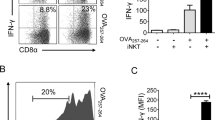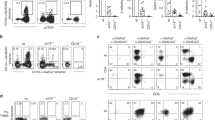Abstract
The chlamydial glycolipid exoantigen (GLXA), a glycolipid antigen derived from Chlamydia muridarum, has been implicated in chlamydial–host cell interaction. Although glycolipid antigens from Sphingomonas and related bacteria have been shown to activate invariant natural killer T (iNKT) cells, it is not yet known whether GLXA can activate these cells. In this study, we have for the first time investigated the role of GLXA in iNKT cell activation using in vitro as well as in vivo settings. First, we examined the effect of GLXA on iNKT cell activation in a cell-free antigen-presentation assay, and found that GLXA specifically stimulated iNKT1.4 hybridoma cell produce enhanced amounts of IL-2. Next, we analyzed the effect of pharmacological activation of iNKT cells by GLXA using iNKT cell-deficient (iNKT knockout (KO)) mice and bone marrow-derived dendritic cell (BMDC)–liver mononuclear cell (LMC) coculture system. On stimulation with GLXA, iNKT cells produced higher quantities of cytokines in a CD1d-dependent fashion. More importantly, iNKT cells from GLXA-treated, but not from cell mock-treated, mice showed higher expression of activation marker, CD69, and enhanced production of interferon (IFN)-γ and IL-4 in vivo. Cumulatively, these data provide evidence on the pharmacological ability of GLXA in specifically activating iNKT cells.
This is a preview of subscription content, access via your institution
Access options
Subscribe to this journal
Receive 12 digital issues and online access to articles
$119.00 per year
only $9.92 per issue
Buy this article
- Purchase on Springer Link
- Instant access to full article PDF
Prices may be subject to local taxes which are calculated during checkout





Similar content being viewed by others

References
Schachter, J. Chlamydial infections (first of three parts). N Engl J Med 1978; 298: 428–435.
Darville T, Hiltke TJ . Pathogenesis of genital tract disease due to Chlamydia trachomatis. J Infect Dis 2010; 201( Suppl 2) S114–S125.
Samoff E, Koumans EH, Markowitz LE, Sternberg M, Sawyer MK, Swan D et al. Association of Chlamydia trachomatis with persistence of high-risk types of human papillomavirus in a cohort of female adolescents. Am J Epidemiol 2005; 162: 668–75.
Johnston SC, Messina LM, Browner WS, Lawton MT, Morris C, Dean D et al. C-reactive protein levels and viable I in carotid artery atherosclerosis. Stroke 2001; 32: 2748–52.
Balin BJ, Gérard HC, Arking EJ, Appelt DM, Branigan PJ, Abrams JT et al. Identification and localization of Chlamydia pneumoniae in the Alzheimer’s brain. Med Microbiol Immunol 1998; 187: 23–42.
Grimaldi LM, Pincherle A, Martinelli-Boneschi F, Fillippi M, Patti F, Reggio A et al. An MRI study of Chlamydia pneumoniae infection in Italian multiple sclerosis patients. Mult Scler 2003; 9: 467–471.
Brunham RC, Rey-Ladino J . Immunology of Chlamydia infection: implications for a Chlamydia trachomatis vaccine. Nat Rev Immunol 2005; 5: 149–161.
Stuart ES, Macdonald AB . Some characteristics of a secreted chlamydial antigen recognized by IgG from C. trachomatis patient sera. Immunology 1989; 68: 469–473.
Stuart ES, Tirrell SM, MacDonald AB . Characterization of an antigen secreted by Chlamydia-infected cell culture. Immunology 1987; 61: 527–533.
Stuart ES, Wyrick PB, Choong J, Stoler SB, MacDonald AB . Examination of chlamydial glycolipid with monoclonal antibodies: cellular distribution and epitope binding. Immunology 1991; 74: 740–747.
Webley WC, Vora GJ, Stuart ES . Cell surface display of the chlamydial glycolipid exoantigen (GLXA) demonstrated by antibody-dependent complement-mediated cytotoxicity. Curr Microbiol 2004; 49: 13–21.
Vora GJ, Stuart ES . A role for the glycolipid exoantigen (GLXA) in chlamydial infectivity. Curr Microbiol 2003; 46: 217–223.
Wyrick PB, Davis CH, Raulston JE, Knight ST, Choong J . Effect of clinically relevant culture conditions on antimicrobial susceptibility of Chlamydia trachomatis. Clin Infect Dis 1994; 19: 931–936.
An LL, Hudson AP, Prendergast RA, O’Brien TP, Stuart ES, Whittum-Hudson JA et al. Biochemical and functional antigenic mimicry by a polyclonal anti-idiotypic antibody for chlamydial exoglycolipid antigen. Pathobiology 1997; 65: 229–240.
Whittum-Hudson JA, An LL, Saltzman WM, Prendergast RA, MacDonald AB . Oral immunization with an anti-idiotypic antibody to the exoglycolipid antigen protects against experimental Chlamydia trachomatis infection. Nat Med 1996; 2: 1116–1121.
Godfrey DI, McCluskey J, Rossjohn J . CD1d antigen presentation: treats for NKT cells. Nat Immunol 2005; 6: 754–756.
Kronenberg, M. Toward an understanding of NKT cell biology: progress and paradoxes. Annu Rev Immunol 2005; 23: 877–900.
Godfrey DI, MacDonald HR, Kronenberg M, Smyth MJ, van Kaer L . NKT cells: what’s in a name? Nat Rev Immunol 2004; 4: 231–237.
Brossay L, Chioda M, Burdin N, Koezuka Y, Casorati G, Dellabona P et al. CD1d-mediated recognition of an alpha-galactosylceramide by natural killer T cells is highly conserved through mammalian evolution. J Exp Med 1998; 188: 1521–1528.
Kawano T, Cui J, Koezuka Y, Toura I, Kaneko Y, Motoki K et al. CD1d-restricted and TCR-mediated activation of valpha14 NKT cells by glycosylceramides. Science 1997; 278: 1626–1629.
Taniguchi M, Harada M, Kojo S, Nakayama T, Wakao H . The regulatory role of Valpha14 NKT cells in innate and acquired immune response. Annu Rev Immunol 2003; 21: 483–513.
Carnaud C, Lee D, Donnars O, Park SH, Beavis A, Koezuka Y et al. Cutting edge: cross-talk between cells of the innate immune system: NKT cells rapidly activate NK cells. J Immunol 1999; 163: 4647–4650.
Skold M, Behar SM . Role of CD1d-restricted NKT cells in microbial immunity. Infect Immun 2003; 71: 5447–5455.
Yang Y, Bao M, Yoon JW . Intrinsic defects in the T-cell lineage results in natural killer T-cell deficiency and the development of diabetes in the nonobese diabetic mouse. Diabetes 2001; 50: 2691–2699.
Smyth MJ, Thia KY, Street SE, Cretney E, Trapani JA, Taniguchi M et al. Differential tumor surveillance by natural killer (NK) and NKT cells. J Exp Med 2000; 191: 661–668.
Kukreja A, Maclaren NK . NKT cells and type-1 diabetes and the “hygiene hypothesis” to explain the rising incidence rates. Diabetes Technol Ther 2002; 4: 323–333.
Mattner J, Debord KL, Ismail N, Goff RD, Cantu C 3 rd, Zhou D et al. Exogenous and endogenous glycolipid antigens activate NKT cells during microbial infections. Nature 2005; 434: 525–529.
Kinjo Y, Wu D, Kim G, Xing GW, Poles MA, Ho DD et al. Recognition of bacterial glycosphingolipids by natural killer T cells. Nature 2005; 434: 520–525.
Kinjo Y, Tupin E, Wu D, Fujio M, Garcia-Navarro R, Benhnia MR et al. Natural killer T cells recognize diacylglycerol antigens from pathogenic bacteria. Nat Immunol 2006; 7: 978–986.
Bilenki L, Wang S, Yang J, Fan Y, Joyee AG, Yang X . NK T cell activation promotes Chlamydia trachomatis infection in vivo. J Immunol 2005; 175: 3197–3206.
Joyee AG, Qiu H, Wang S, Fan Y, Bilenki L, Yang X . Distinct NKT cell subsets are induced by different Chlamydia species leading to differential adaptive immunity and host resistance to the infections. J Immunol 2007; 178: 1048–1058.
Whittum-Hudson JA, Rudy D, Gèrard H, Vora G, Davis E, Haller PK et al. The anti-idiotypic antibody to chlamydial glycolipid exoantigen (GLXA) protects mice against genital infection with a human biovar of Chlamydia trachomatis. Vaccine 2001; 19: 4061–4071.
Chiba A, Cohen N, Brigl M, Brennan PJ, Besra GS, Brenner MB . Rapid and reliable generation of invariant natural killer T-cell lines in vitro. Immunology 2009; 128: 324–333.
Cui J, Shin T, Kawano T, Sato H, Kondo E, Toura I et al. Requirement for Valpha14 NKT cells in IL-12-mediated rejection of tumors. Science 1997; 278: 1623–1626.
Inaba K, Inaba M, Romani N, Aya H, Deguchi M, Ikehara S et al. Generation of large numbers of dendritic cells from mouse bone marrow cultures supplemented with granulocyte/macrophage colony-stimulating factor. J Exp Med 1992; 176: 1693–1702.
Yang X, HayGlass KT, Brunham RC . Genetically determined differences in IL-10 and IFN-gamma responses correlate with clearance of Chlamydia trachomatis mouse pneumonitis infection. J Immunol 1996; 156: 4338–4344.
McCarthy C, Shepherd D, Fleire S, Stronge VS, Koch M, Illarionov PA et al. The length of lipids bound to human CD1d molecules modulates the affinity of NKT cell TCR and the threshold of NKT cell activation. J Exp Med 2007; 204: 1131–1144.
Sriram V, Du W, Gervay-Hague J, Brutkiewicz RR . Cell wall glycosphingolipids of Sphingomonas paucimobilis are CD1d-specific ligands for NKT cells. Eur J Immunol 2005; 35: 1692–1701.
Acknowledgements
This work was supported by grants from National Natural Sciences Foundation of China (nos. 30770110 and 30811120425) to WZ and a grant from Canadian Institutes of Health Research (CCI 92213) to XY. YP and LZ were supported by PhD Studentships for Oversea Study from Shandong University.
Author information
Authors and Affiliations
Rights and permissions
About this article
Cite this article
Peng, Y., Zhao, L., Shekhar, S. et al. The glycolipid exoantigen derived from Chlamydia muridarum activates invariant natural killer T cells. Cell Mol Immunol 9, 361–366 (2012). https://doi.org/10.1038/cmi.2012.19
Received:
Revised:
Accepted:
Published:
Issue Date:
DOI: https://doi.org/10.1038/cmi.2012.19
Keywords
This article is cited by
-
Genital tract lesions in sexually mature Göttingen minipigs during the initial stages of experimental vaginal infection with Chlamydia trachomatis serovar D
BMC Veterinary Research (2016)
-
From the Deep Sea to Everywhere: Environmental Antigens for iNKT Cells
Archivum Immunologiae et Therapiae Experimentalis (2016)
-
Activation of CD1d-restricted natural killer T cells can inhibit cancer cell proliferation during chemotherapy by promoting the immune responses in murine mesothelioma
Cancer Immunology, Immunotherapy (2014)
-
The role of invariant natural killer T cells in microbial immunity
Journal of Infection and Chemotherapy (2013)


